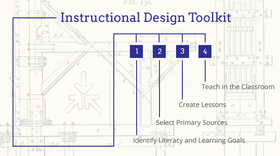Primary Source Exemplar Template
Unit Abstract
Standards Alignment
Guidelines: Identify the Common Core State Standards and other subject-specific standards that will be the lesson/unit's primary focus for teaching, learning, and assessment.
CCSS ELA/Literacy Grade Level Standards
CCSS Math Standards
Subject-Specific Standards
Source List
Guidelines: Select and sequence set of coherent primary source texts in line with your identified literacy and learning goals. This should include an anchor text and a set of supporting texts that can be strategically sequenced to develop students’ knowledge and skills. Look for texts that are meaningful, rich and worthy of study, consider texts that are typical for your discipline (e.g., data sets for science), and remember to evaluate the texts for complexity.
Anchor text
Supporting texts
Developing Student Literacy
Guidelines: Instructional design will build upon CCSS Key Shifts and demonstrate and support student close reading of texts, deriving textbased evidence through questioning, building arguments from the texts, application of the text to historical or contemporary real world situations, and fluency with vocabulary for writing and speaking about new understandings.
Rationale
CCSS Areas of Focus
Reading Text Closely: Makes reading text(s) closely, examining textual evidence, and discerning deep meaning a central focus of instruction.
Explanation:
Text Based Evidence: Facilitates rich and rigorous evidence based discussions and writing about common texts through a sequence of specific, thought provoking, and text dependent questions (including, when applicable, questions about illustrations, charts, diagrams, audio/video, and media).
Explanation:
Writing from Sources: Routinely expects that students draw evidence from texts to produce clear and coherent writing that informs, explains, or makes an argument in various written forms (e.g., notes, summaries, short responses, or formal essays).
Explanation:
Academic Vocabulary: Focuses on building students’ academic vocabulary in context throughout instruction.
Explanation:
Building Disciplinary Knowledge: Provides opportunities for students to build knowledge about a topic or subject through analysis of a coherent selection of strategically sequenced, discipline-specific texts.
Explanation:
Direct Learning Through Questions
Guidelines: Determine your overarching, essential question that unifies learning across texts, disciplines, and lessons, and that is tied to your learning objectives. Also determine your text-based, topic-specific questions might to promote close reading of your selected texts. Ask yourself: What questions help students draw their own conclusions based on observations of the texts? What questions should be added to help students who may need additional support, or who may lack some of the prerequisite knowledge needed to access the texts? How do the text-based questions relate to the overall essential question(s)?
Essential Question(s)
Text-Based Questions
Integrate Learning Across Disciplines
Guidelines: How is instruction designed (and, for K-5, sequenced) to integrate learning across subject areas? What standards, key areas of focus, and/or essential ideas are addressed in lessons focused on mathematics, science, social studies, the arts, etc.?
Common Areas of Focus, and/or Essential Ideas
Strategies to Integrate Learning Across Disciplines
Align Assessment with Instruction
Guidelines: How does the culminating student task provide for summative assessment of the standards targeted and the skills and knowledge developed during the unit? How do student activities/tasks within lessons provide opportunities to develop and formatively assess the targeted skills and knowledge?
Culminating/Summative Assessment Task
Formative Assessment Strategies
Consider Background Knowledge and Prerequisite Skills
Guidelines: What previous learning might be needed for students to succeed in the unit? How might students’ background and skills be pre-assessed to determine their readiness for learning?
Prerequisite Learning
Pre-assessment of Readiness for Learning
Provide Support While Building Toward Independence
Guidelines: How are all students supported in reading (and/or extending beyond) text of grade-level complexity? What additional support might be provided for students who are ELL, have disabilities, or read well below grade level?
Strategies for Supporting All Students and Building Independence
Additional Suggestions for Support/Extension
English language learners:
Students with disabilities:
Below grade level readers:
Above grade-level readers:
Sequence the Lessons
Guidelines: What are the major instructional activities, and how are they sequenced to provide a coherent progression of learning? Within each activity, how is direct instruction in your subject area balanced with instruction to meet the literacy standards?
Lesson 1 [title and brief description]
Lesson 2 [title and brief description]
Lesson 3 [title and brief description]
Lesson ...
Lesson ....
Summative Assessment [brief description]
